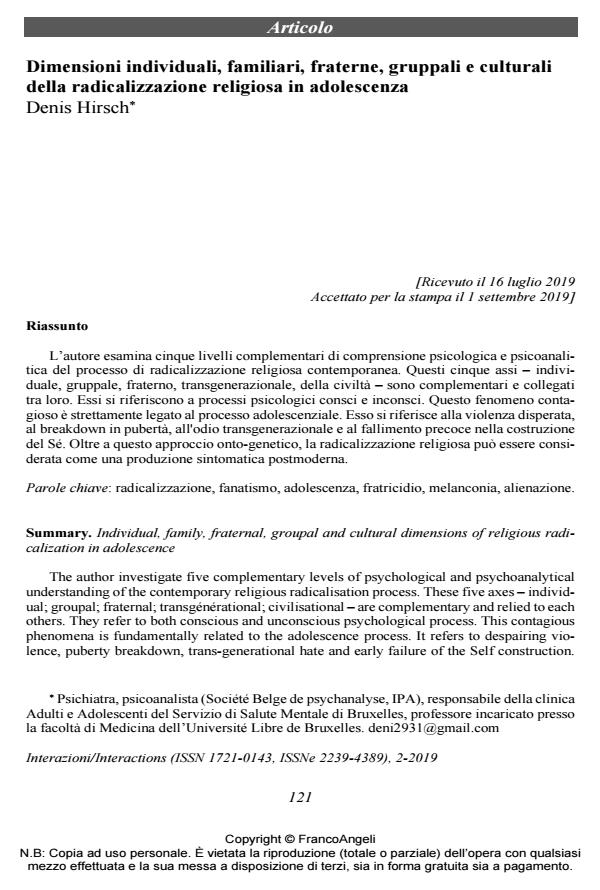Individual, family, fraternal, groupal and cultural dimensions of religious radicalization in adolescence
Journal title INTERAZIONI
Author/s Denis Hirsch
Publishing Year 2019 Issue 2019/2
Language Italian Pages 17 P. 121-137 File size 210 KB
DOI 10.3280/INT2019-002008
DOI is like a bar code for intellectual property: to have more infomation
click here
Below, you can see the article first page
If you want to buy this article in PDF format, you can do it, following the instructions to buy download credits

FrancoAngeli is member of Publishers International Linking Association, Inc (PILA), a not-for-profit association which run the CrossRef service enabling links to and from online scholarly content.
The author investigate five complementary levels of psychological and psychoanalytical understanding of the contemporary religious radicalisation process. These five axes ‒ individ-ual; groupal; fraternal; transgénérational; civilisational ‒ are complementary and relied to each others. They refer to both conscious and unconscious psychological process. This contagious phenomena is fundamentally related to the adolescence process. It refers to despairing vio-lence, puberty breakdown, trans-generational hate and early failure of the Self construction. Beside this onto-genetic approach, religious radicalisation may be considered as a symptomatic post-modern production.
Keywords: Radicalization, fanatism, adolescence, fratricide, melancholy, alienation.
- Assoun P-L. (2015). Le préjudice radical: de l’idéal à la destruction. In Benslama F., L’idéal et la cruauté. Subjectivité et politique de la radicalisation. Paris: Lignes.
- Atran S. (2011). Genesis of Suicide Terrorism. [archive] sciencemag.org
- Benslama F. (2015). L’idéal blessé et le surmusulman. In Benslama F., L’idéal et la cruauté. Subjectivité et politique de la radicalisation. Paris: Lignes.
- Benslama F., Khosrokhavar F. (2017). Le Jihadisme des femmes. Pourquoi ont-elles choisi Daesh? Paris: Le Seuil.
- Benzine R. (2016). Nour, pourquoi n’ai-je rien vu venir? Paris: Le Seuil.
- Celan P. (1952). Mohn und Gedächtnis/Pavot et mémoire, 1952. Schneepart, Paris: Mercure de France, 1978.
- Fain M., Braunschweig D. (1975). La Nuit, le Jour. Essai psychanalytique sur le fonctionnement mental. Paris: Le Fil Rouge.
- Ferenczi S. (1932). Confusion de langue entre les adultes et l’enfant. In Ferenczi S., Psychanalyse IV. Paris: Payot, 1982.
- Freud S. (1914). Introduzione al narcisismo. OSF, vol. 7. Torino: Bollati Boringhieri.
- Freud S. (1916). Alcuni tipi di carattere tratti dal lavoro psicoanalitico. OSF, vol. 8. Torino: Bollati Boringhieri.
- Freud S. (1915 [1917]). Metapsicologia: Lutto e melanconia. OSF, vol. 8. Torino: Bollati Boringhieri.
- Freud S. (1930 [1929]). Il disagio della civiltà. OSF, vol. 10. Torino: Bollati Boringhieri.
- Gutton P. (1991). Le Pubertaire. Paris: PUF, Le Fil Rouge.
- Haddad G. (2017). Le complexe de Caïn: terrorisme, haine de l’autre et rivalité fraternelle. Paris: Premier Parallèle.
- Hirsch D. (2015). Travail du négatif dans les trauma collectifs et mal-être actuel dans la culture: convergences et filiation. In Kaës R. et al., Crises et traumas à l’épreuve du temps. Paris: Dunod.
- Hirsch D. (2017). Identifications aliénantes et radicalisme religieux. Cahiers de Psychologie Clinique, 2: 105-123.
- Jeammet P. (1984). La thérapie bifocale. Adolescence, 10, 2: 371-383.
- Kaës R. (2009). Les alliances inconscientes. La psychanalyse à l’épreuve du groupe». Paris: Dunod.
- Kaës R. (2015). Le complexe fraternel. Paris: Dunod.
- Kaës R. (2016). L’idéologie; L’idéal, l’idée, l’idole. Paris: Dunod.
- Khosrokhavar F. (2016). Radicalization, Why Some People Choose the Path of Violence. New York: The New Press.
- Kristeva J. (2007). Cet incroyable besoin de croire. Paris: Bayard.
- Nathan T. (2017). Les âmes errantes. Paris: Les Iconoclastes.
- Racamier P.-C. (1989). Antoedipe et ses destins. Paris: Collège de Psychanalyse.
- Roussillon R. (2005). Le paradoxe de la destructivité ou l’utilisation de l’objet selon Winnicott. In Roussillon R., Paradoxes et situations limites de la psychanalyse. Paris: PUF, Coll. Quadrige.
- Roussillon R. (2009). La destructivité et les formes complexes de la survivance de l’objet. Revue Française de Psychanalyse, LXXIII, 4: 1005-1022.
- Stein R. (2002). Le mal comme amour et libération: l’état d’esprit d’un terroriste kamikaze religieux. Revue Française de Psychanalyse, LXVI, 3: 897-922. DOI : 10.3917/rfp.663.0897.
- Winnicott D.W. (1971). L’uso dell’oggetto. In Winnicott D.W., Gioco e realtà. Roma: Armando.
- Winnicott D.W. (1974). La paura del crollo. In Winnicott D.W., Esplorazioni psicoanalitiche. Milano: Raffaello Cortina.
Denis Hirsch, Dimensioni individuali, familiari, fraterne, gruppali e culturali della radicalizzazione religiosa in adolescenza in "INTERAZIONI" 2/2019, pp 121-137, DOI: 10.3280/INT2019-002008